4–6 New Market, Beccles, Suffolk, NR34 9HA
This was designated a grade II listed building on 22 September 1971. It is described as ‘17th and 18th century, with alteration’. The 18th-century Georgian-style parts flank the earlier section of the building – two storeys high, with three gabled dormers facing Sheepgate Street. Being a former coaching inn, the main entrance (facing New Market) was an open archway, until fairly recently, leading into a cobbled yard with galleries at the back and stables at the rear.
Prints and text about The King’s Head Hotel.
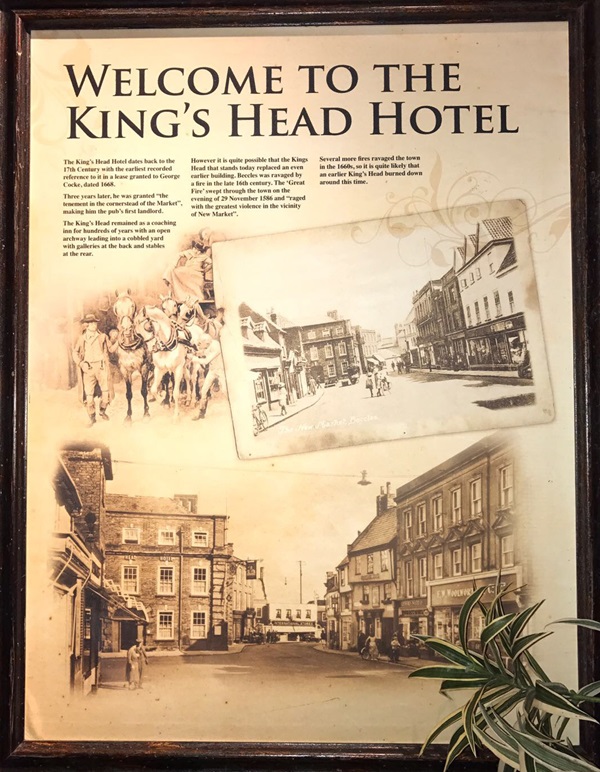
The text reads: The King’s Head Hotel dates back to the 17th century with the earliest recorded reference to it in a lease granted to George Cocke, dated 1668.
Three years later, he was granted “the tenement in the cornerstead of the Market”, making him the pub’s first landlord.
The King’s Head remained as a coaching inn for hundreds of years with an open archway leading into a cobbled yard with galleries at the back and stables at the rear.
However it is quite possible that the Kings Head that stands today replaces an even earlier building. Beccles was ravaged by a fire in the late 16th century. The Great Fire swept through the town on the evening of 29 November 1586 and “raged with the greatest violence in the vicinity of New Market”.
Several more fires ravaged the town in the 1660s, so it is quite likely that an earlier King’s Head burned down around this time.
A plaque documenting the history of The King’s Head Hotel.
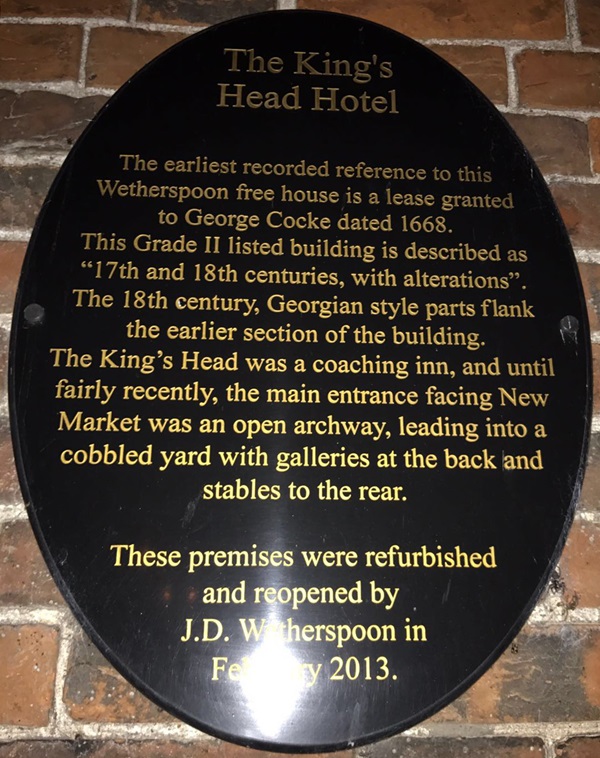
The plaque reads: The earliest recorded reference to this Wetherspoon free house is a lease granted to George Cocke dated 1668. This Grade II listed building is described as “17th and 18th centuries, with alterations”. The 18th century, Georgian style parts flank the earlier section of the building. The King’s Head was a coaching inn, and until fairly recently, the main entrance facing New Market was an open archway, leading into a cobbled yard with galleries at the back and stables to the rear.
These premises were refurbished and reopened by J D Wetherspoon in February 2013.
A print entitled The Portreeve’s Feast at Beccles, by Jonathan Chadwick.
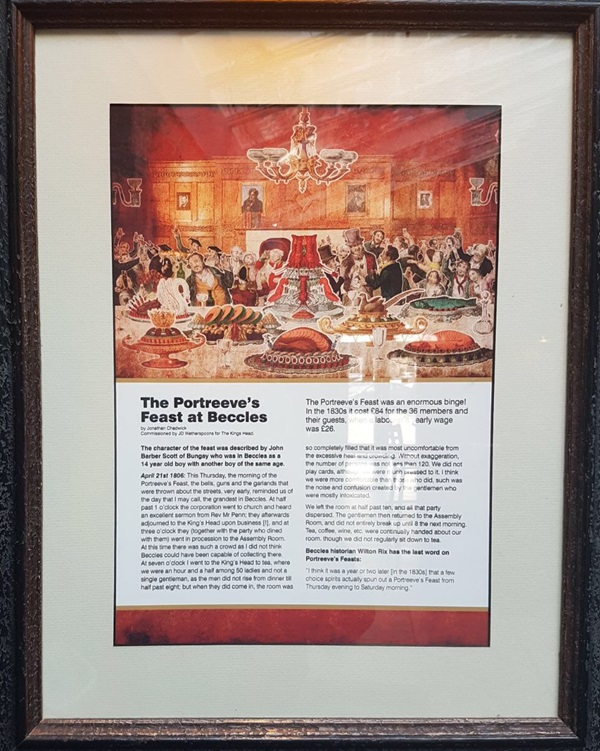
The text reads: The character of the feast was described by John Barber Scott of Bungay who was in Beccles as a 14 year old boy with another boy of the same age.
April 21 1806: This Thursday, the morning of the Portreeve’s Feast, the bells, guns and the garlands that were thrown about the streets, very early, reminded us of the day that I may call, the grandest in Beccles. At half past 1 o’clock the corporation went to church and heard an excellent sermon from Rev Mr Penn; they afterwards adjourned to the King’s Head upon business [!], and at three o’clock they (together with the party who dined with them) went in procession to the Assembly Room. At this time there was such a crowd as I did not think Beccles could have been capable of collecting there. At seven o’clock I went to the King’s Head to tea, where we were an hour and a half among 50 ladies and not a single gentleman, as the men did not rise from dinner till half past eight; but when they did come in, the room was so completely filled that it was most uncomfortable from the excessive heat and crowding. Without exaggeration, the number of persons was not less than 120. We did not play cards, although we were much pressed to it. I think we were more comfortable than those who did, such was the noise and confusion created by the gentlemen who were mostly intoxicated. We left the room at half past ten, and all that party dispersed. The gentlemen then returned to the Assembly Room, and did not entirely break up until 8 the next morning. Tea, coffee, wine, etc. were continually handed about our room, though we did not regularly sit down to tea.
Beccles historian Wilton Rix has the last word on Portreeve’s Feasts:
“I think it was a year or two later [in the 1830s] that a few choice spirits actually spun out a Portreeve’s Feat from Thursday evening to Saturday morning.”
A poem by George Crabbe transcribed onto a plaque.
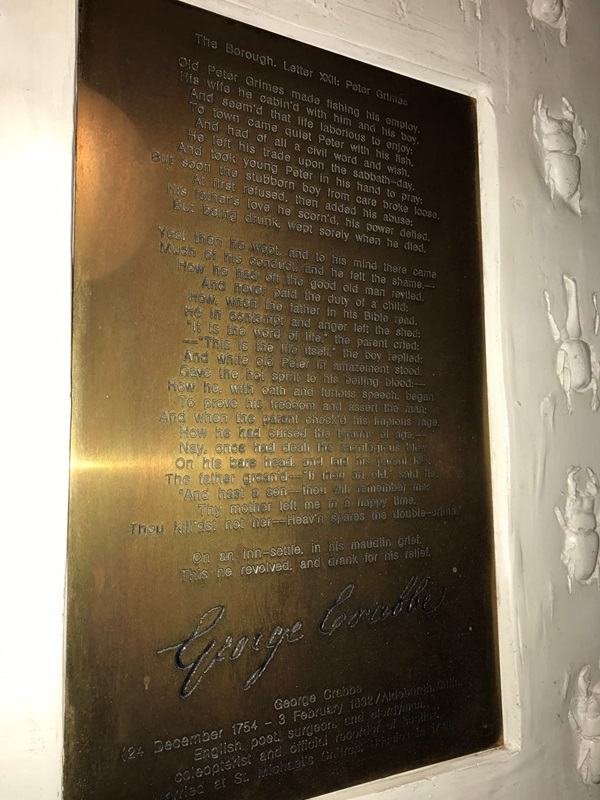
The plaque reads: Old Peter Grimes made fishing his employ,
His wife he cabined with him and his boy,
And seemed that life laborious to enjoy:
To town came quiet Peter with his fish,
And had of all a civil word and wish.
He left his trade upon the Sabbath day,
And took young Peter in his hand to pray;
But soon the stubborn boy from care broke loose,
At first refused, then added his abuse;
His father's love he scorned, his power defied,
But, being drunk, wept sorely when he died.
Yes! then he wept, and to his mind there came
Much of his conduct, and he felt the shame:
How he had oft the good old man reviled,
And never paid the duty of a child;
How, when the father in his Bible read,
He in contempt and anger left the shed;
"It is the word of life," the parent cried;
"This is the life itself," the boy replied;
And while old Peter in amazement stood,
Gave the hot spirit to his boiling blood:
How he, with oath and furious speech, began
To prove his freedom and assert the man;
And when the parent checked his impious rage,
How he had cursed the tyranny of age —
Nay, once had dealt the sacrilegious blow
On his bare head, and laid his parent low:
The father groaned — "If thou art old," said he,
"And hast a son — thou wilt remember me;
Thy mother left me in a happy time,
Thou kill'dst not her — Heaven spares the double crime."
On an inn-settle, in his maudlin grief,
This he revolved, and drank for his relief.
Text about the plaque above, created by Flo Flozzard.
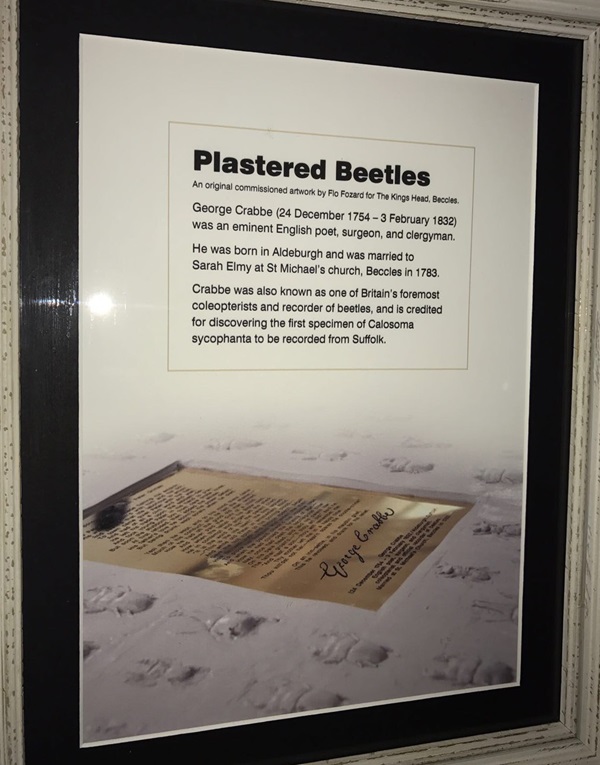
The text reads: George Crabbe (24 December 1754 – 3 February 1832) was an eminent English poet, surgeon and clergyman. He was born in Aldeburgh and was married to Sarah Elmy at St Michael’s church, Beccles in 1783. Crabbe was also known as one of Britain’s foremost coleopterists and recorder of beetles, and is credited for discovering the first specimen of Calosoma sycophanta to be recorded from Suffolk.
Prints and text about Sir John Leman.
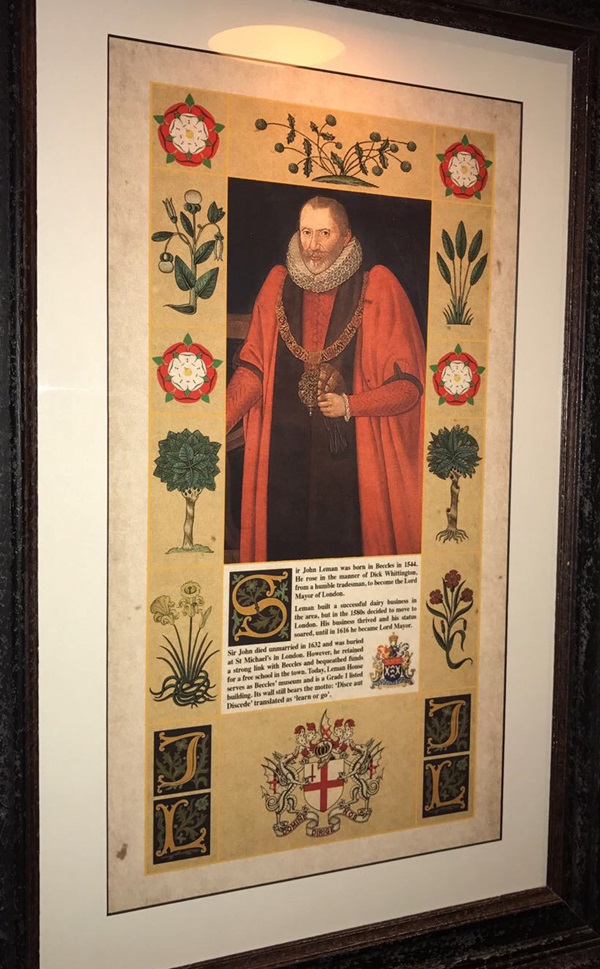
The text reads: Sir John Leman was born in Beccles in 1544. He rose in the manner of Dick Whittington, from a humble tradesman, to become the Lord Mayor of London.
Leman built a successful dairy business in the area, but in the 1580s decided to move to London. His business thrived and his status soared, until in 1616 he became Lord Mayor.
Sir John died unmarried in 1632 and was buried at St Michael’s in London. However, he retained a strong link with Beccles and bequeathed funds for a free school in the town. Today, Leman House serves as Beccles’ museum and is a Grade I listed building. Its wall still bears the motto: ‘Disce aut Discede’ translated as ‘learn or go’.
A print and text about Beccles printing industry.
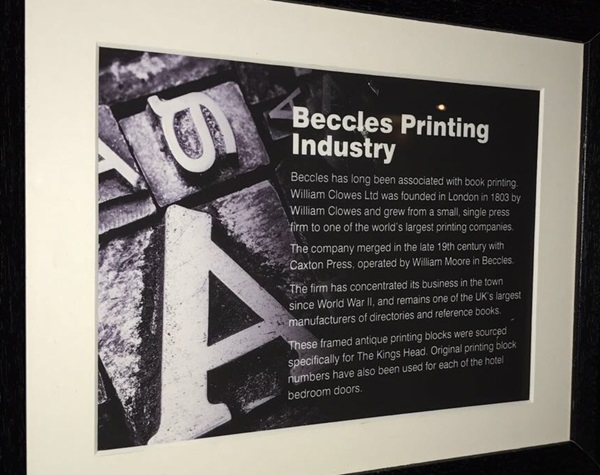
The text reads: Beccles has long been associated with book printing. William Clowes Ltd was founded in London in 1803 by William Clowes and grew from a small, single press firm to one of the world’s largest printing companies. The company merged in the late 19th century with Caxton Press, operated by William Moore in Beccles. The firm has concentrated its business in the town since World War II, and remains one of the UK’s largest manufacturers of directories and reference books. These framed antique printing blocks were sourced specifically for The King’s Head. Original printing block numbers have also been used for each of the hotel bedroom doors.
A photograph and text about clock making.
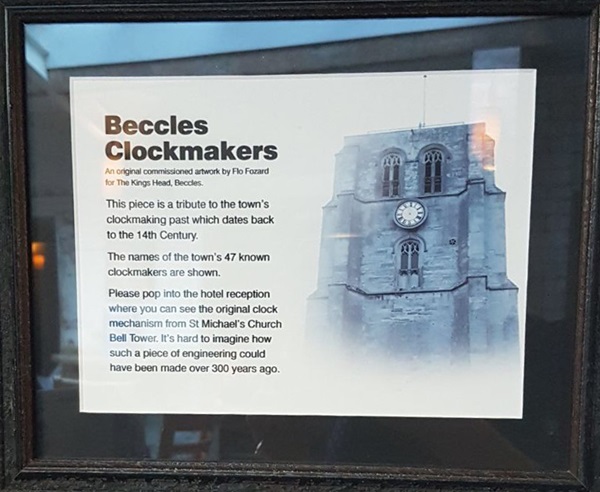
The text reads: This piece is a tribute to the town’s clock making past which dates back to the 14th century. The names of the town’s 47 known clockmakers are shown. Please pop into the hotel reception where you can see the original clock mechanism from St Michael’s Church Bell Tower. It’s hard to imagine how such a piece of engineering could have been made over 300 years ago.
Prints and text about the designer’s philosophy for The King’s Head.
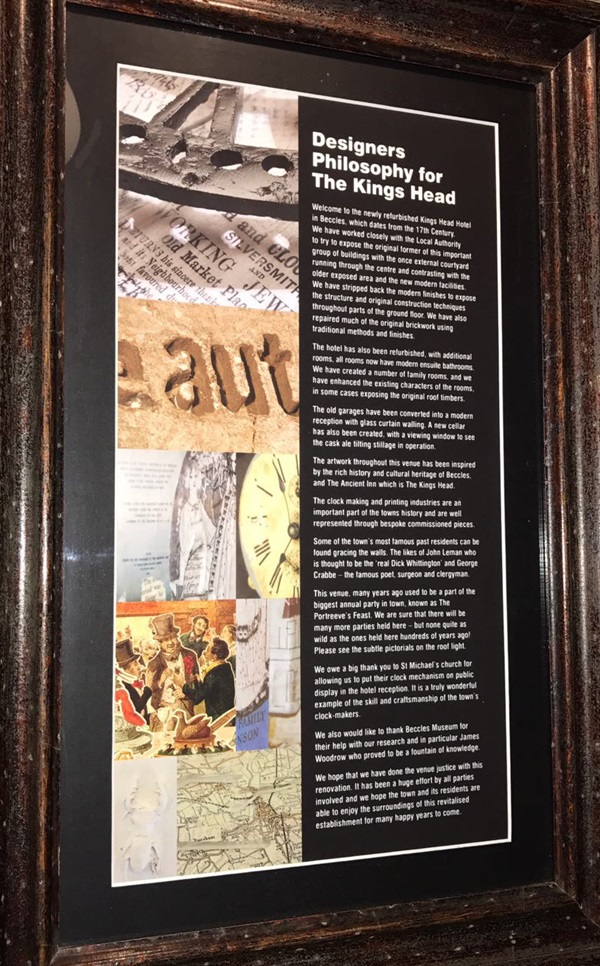
The text reads: Welcome to the newly refurbished King’s Head Hotel in Beccles, which dates from the 17th century. We have worked closely with the local authority to try to expose the original form of this important group of buildings with the once external courtyard running through the centre and contrasting with the older exposed area and the new modern facilities. We have stripped back the modern finishes to expose the structure and original construction techniques throughout parts of the ground floor. We have also repaired much of the original brickwork using traditional methods and finishes.
The hotel has also been refurbished, with additional rooms, all rooms now have modern ensuite bathrooms. We have created a number of family rooms, and we have enhanced the existing characters of the rooms, in some cases exposing the original roof timbers.
The old garages have been converted into a modern reception with glass curtain walling. A new cellar has also been created, with a viewing window to see the cask ale tilting stillage in operation.
The artwork throughout this venue has been inspired by the rich history and cultural heritages of Beccles, and The Ancient Inn which is The King’s Head.
The clock making and printing industries are an important part of the town’s history and are well represented through bespoke commissioned pieces.
Some of the town’s most famous past residents can be found gracing the walls. The likes of John Leman who is thought to be the real Dick Whittington and George Crabbe – the famous poet, surgeon and clergyman.
This venue, many years ago used to be a part of the biggest annual party in town, known as The Portreeve’s Feast. We are sure that there will be many more parties held here – but none quite as wild as the ones held here hundreds of years ago! Please see the subtle pictorials on the roof light.
We owe a big thank you to St Michael’s church for allowing us to put their clock mechanism on public display in the hotel reception. It is a truly wonderful example of the skill and craftsmanship of the town’s clockmakers.
We also would like to thank Beccles Museum for their help with our research and in particular James Woodrow who proved to be a fountain of Knowledge.
We hope that we have done the venue justice with this renovation. It has been a huge effort by all parties involved and we hope the town and its residents are able to enjoy the surroundings of this revitalised establishment for many happy years to come.
A print and text about the hourglass.
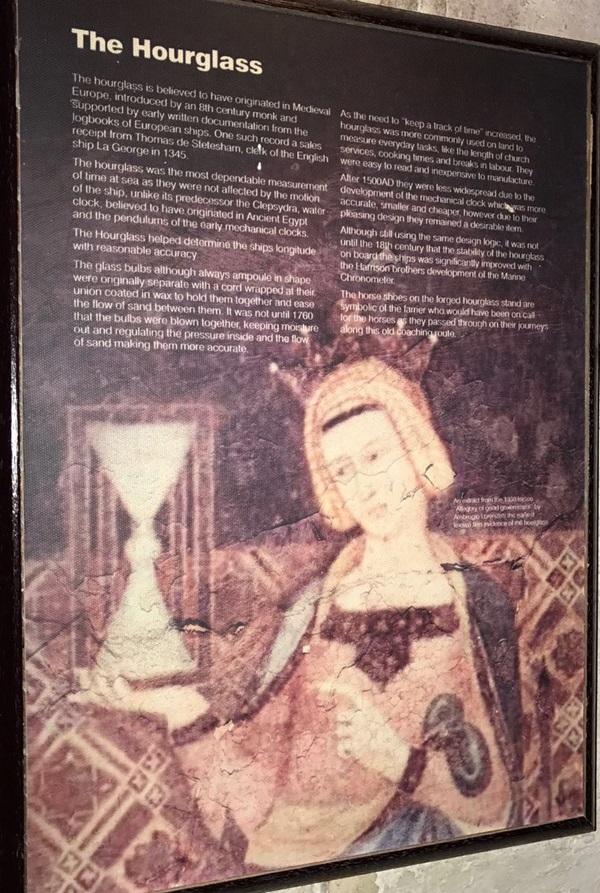
The text reads: The hourglass is believed to have originated in Medieval Europe, introduced by an 8th century monk and supported by early written documentation from the log books of European ships. One such record a sales receipt from Thomas de Stetesham, clerk of the English ship La George in 1345.
The hourglass was the most dependable measurement of time at sea as they were not affected by the motion of the ship, unlike its predecessor the Clepsydra, water clock, believed to have originated in Ancient Egypt and the pendulums of the early mechanical clocks.
The hourglass helped determine the ships longitude with reasonable accuracy.
The glass bulbs although always ampoule in shape were originally separate with a cord wrapped at their union coated in wax to hold them together and ease the flow of sand between them. It was not until the 1760 that the bulbs were blown together, keeping moisture out and regulating the pressure inside and the flow of sand making them more accurate.
As the need to “keep a track of time” increased, the hourglass was more commonly used on land to measure everyday tasks, like the length of church services, cooking times and breaks in labour. They were easy to read and inexpensive to manufacture.
After 1500AD they were less widespread due to the development of the mechanical clock which was more accurate, smaller and cheaper, however due to their pleasing design they remained a desirable item.
Although still using the same design logic, it was not until the 18th century that the stability of the hourglass on board the ships was significantly improved with the Harrison brother’s development of the Marine Chronometer.
The horse shoes on the forged hourglass stand are symbolic of the farrier who would have been on call for the horses, as they passed through on their journey along this old coaching route.
Photographs and text about St Michael’s church clock mechanism.
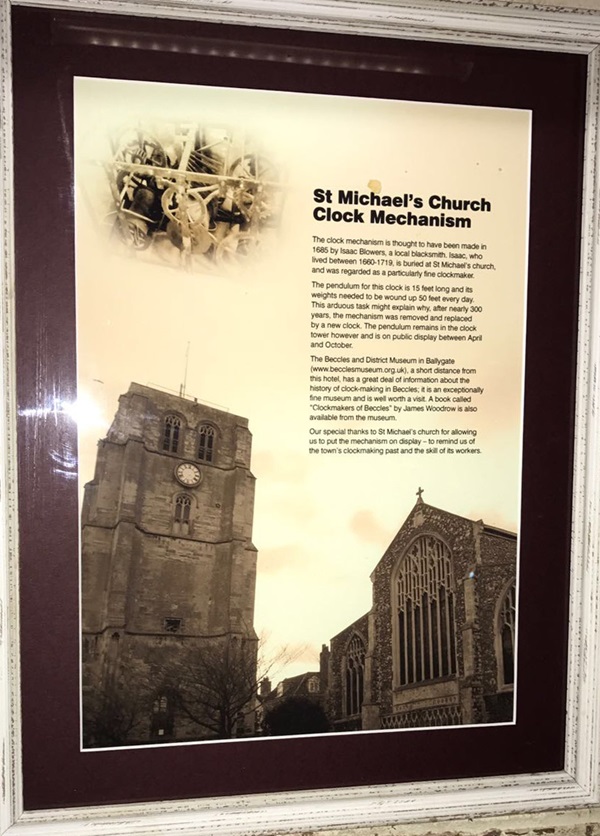
The text reads: The clock mechanism is thought to have been made in 1685 by Isaac Blowers, a local blacksmith. Isaac, who lived between 1660-1719, is buried at St Michael’s church, and was regarded as a particularly fine clockmaker.
The pendulum for this clock is 15 feet long and its weights needed to be wound up 50 feet every day. The arduous task might explain why, after nearly 300 years, the mechanism was removed and replaced by a new clock. The pendulum remains in the clock tower however and is on public display between April and October.
The Beccles and District Museum in Ballygate (www.becclesmuseum.org.uk), a short distance from this hotel, has a great deal of information about the history of clock making in Beccles; it is an exceptionally fine museum and is well worth a visit. A book called Clockmakers of Beccles by James Woodrow is also available from the museum.
Our special thanks to St Michael’s church for allowing us to put the mechanism on display – to remind us of the town’s clock making past and the skill of its workers.
Papier mache art and text about Sir John Leman.
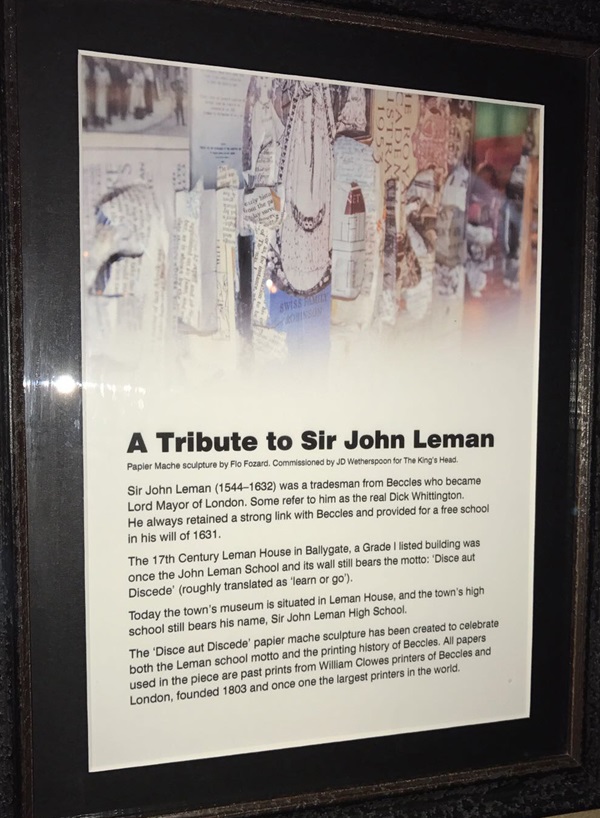
The text reads: Sir John Leman (1544-1632) was a tradesman from Beccles who became Lord Mayor of London. Some refer to him as the real Dick Whittington. He always retained a strong link with the Beccles and provided for a free school in his will of 1631.
The 17th century Leman House, and the town’s high school still bears his name, Sir John Leman High School.
The Disce aut Discede papier mache sculpture has been created to celebrate both the Leman school motto and the printing history of Beccles. All papers used in the piece are past prints from William Clowes printers of Beccles and London, founded 1803 and once one of the largest printers in the world.
External photograph of the building – main entrance.
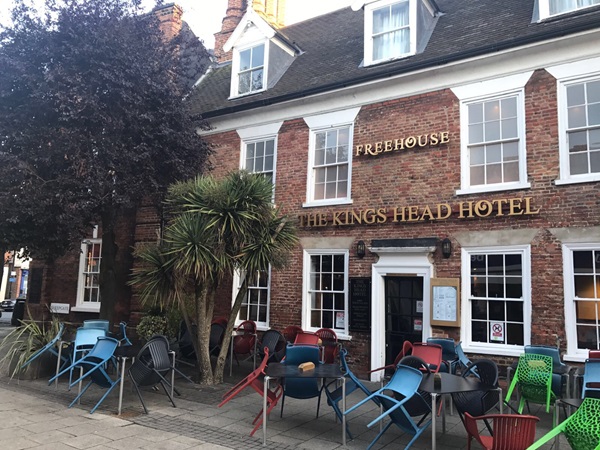
If you have information on the history of this pub, then we’d like you to share it with us. Please e-mail all information to: pubhistories@jdwetherspoon.co.uk